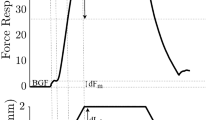Summary
Electromyographic (EMG) reflex responses were examined in the biceps muscle of awake Cebus monkeys trained to resist perturbations of a handle with their forearm. In particular responses at latencies of 15–20 msec (M1) and 40–55 msec (M2), thought to correspond to segmental and suprasegmental reflex pathways respectively, were studied. The experiments demonstrated that the magnitude of the m1 response was large, as compared to M2, only when the muscle was tonically active and small perturbations were applied. For larger perturbations the magnitude of M1 saturated and the M2 response became functionally significant, its magnitude being directly related to the magnitude of the perturbation. By means of delayed reductions in torque, the magnitude of this M2 response was also shown to be very sensitive to changes in facilitatory drive provided by segmental pathways.
Similar content being viewed by others
References
Basmajian, J.V.: Electrodes and electrode connectors. In: New Developments in Electromyography and Clinical Neurophysiology. (ed. J.E. Desmedt). Vol. I, p. 502–510. Basel: Karger 1973
Conrad, B., Matsunami, K., Meyer-Lohmann, J., Wiesendanger, M., Brooks, V.B.: Cortical load compensation during voluntary elbow movements. Brain Res. 71, 507–514 (1974)
Conrad, B., Meyer-Lohmann, J., Matsunami, K., Brooks, V.B.: Precentral unit activity following torque pulse injections into elbow movement. Brain Res. 94, 219–236 (1975)
Evarts, E.V.: Motor cortex reflexes accociated with learned movement. Science 179, 501–503 (1973)
Evarts, E.V., Tanji, J.: Gating of motor cortex reflexes by prior instruction. Brain Res. 71, 479–494 (1974)
Hammond, P.H.: Involuntary activity in biceps following the sudden application of velocity to the abducted forearm. J. Physiol. (Lond.) 127, 23–25P (1954)
Hunt, C.C., McIntyre, A.K.: An analysis of fibre diameter and receptor characteristics of myelinated cutaneous afferent fibres in cat. J. Physiol. (Lond.) 153, 99–112 (1960)
Hunt, C.C., Perl, E.R.: Spinal reflex mechanism concerned with skeletal muscle. Physiol. Rev. 40, 538–579 (1960)
Marsden, C.D., Merton, P.A., Morton, H.B.: Latency measurements compatible with a cortical pathway for the stretch reflex in man. J. Physiol. (Lond.) 230, 58–59P (1973)
Melvill-Jones, G., Watt, D.G.D.: Observations on the control of stepping and hopping movements in man. J. Physiol. (Lond.) 219, 709–727 (1971)
Merton, P.A.: The properties of the human muscle servo. Brain Res. 71, 475–478 (1974)
Tatton, W.G., Forner, S.D., Gerstein, G.L., Chamber, W.W., Liu, C.N.: The effect of postcentral cortical lesions on motor responses to sudden upper limb displacements in monkeys. Brain Res. 96, 108–113 (1975)
Author information
Authors and Affiliations
Additional information
Supported in part by grants from the Medical Research Council of Canada (MT-4465) and the National Institutes of Health (NS-10311)
Post-doctoral Fellow supported by the Medical Research Council of Canada
Rights and permissions
About this article
Cite this article
Vilis, T., Cooke, J.D. Modulation of the functional stretch reflex by the segmental reflex pathway. Exp Brain Res 25, 247–254 (1976). https://doi.org/10.1007/BF00234016
Received:
Issue Date:
DOI: https://doi.org/10.1007/BF00234016




